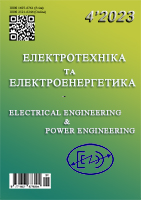Green energy as a key element of the implementation of the concept of distributed generation
DOI:
https://doi.org/10.15588/1607-6761-2023-4-4Keywords:
green energy, distributed generation, mathematical modeling, photovoltaic panels, wind generators, electricity generation, hybrid systemsAbstract
Purpose. The purpose of this article is to study the role of "Green energy" in the concept of generation distribution, to analyze the contribution of renewable sources to the stability of energy. The main tasks include improving models of electric photo panels and wind generators to achieve environmental and economic efficiency.
Methodology. Mathematical modeling of photovoltaic panels and wind generators, analysis of the effect of the precision factor and the efficiency factor of the inverter on power generation. A comparative analysis of the obtained results with real data is used to validate the models. The aerodynamic characteristics of the wind generator and the influence on the output power are studied. An optimized model for forecasting the efficiency of hybrid systems using green technologies is being developed.
Findings. The obtained research results reveal the key contribution of "Green Energy" to the concept of distributed generation. The methods of mathematical model panels and the use of photovoltaic generators, together with the application of the current coefficient and taking into account the efficiency of the inverter, made it possible to increase the accuracy of forecasting electricity generation. The developed model takes into account the aerodynamic characteristics of the wind generator, emphasizing the realized possibility of exceeding the nominal power in accordance with the real characteristics. The obtained results are compared with real data for validation and confirmation of the effectiveness of the system.
Originality. It consists in improving the model of photovoltaic panels, taking into account the influence of the inverter and the aerodynamic features of the wind generator. The work found that the largest generation of wind generators on earth is from October to February, indicating the advantage of combining solar and wind energy.
Practical value. It consists in optimizing the forecasting of electricity generation in hybrid systems, which determined the increase in accuracy and adaptability to real conditions. Your study represents the potential for the development of "Green Energy" in communities with a large area and medium capacity.
References
Prezentovano proekt Kontseptsiyi «zelenoho» ener-hetychnoho perekhodu Ukrayiny do 2050 roku | Kabinet Ministriv Ukrayiny (kmu.gov.ua)
Natsionalʹnyy plan diy z enerhoefektyvnosti na period do 2030 roku | Derzhenerhoefektyvnosti Ukrayiny (saee.gov.ua)
Ohlyad Stratehiyi enerhetychnoyi bezpeky Ukrayiny vid YEUEA – EUEA - European-Ukrainian Energy agency (euea-energyagency.org)
https://www.undp.org/uk/ukraine/tsili-staloho-rozvytku
How Just Transition can help deliver the Paris Agree-ment | Climate Promise (undp.org)
Falaghi, H. ACO Based Algorithm for Distributed Gen-eration Sources Allocation and Sizing in Distribution Systems [Text] / H. Falaghi, M. Haghifam // PowerThech. – 2007. - P. 555-560.
MERRA NASSA [Електронний ресурс] // SoDa pro. – 2019. – Режим доступу до ресурсу: http://www.soda-pro.com/web-services/meteo-data/merra
Litvytsʹka O. I. Vzayemodiya vitrovykh potokiv z oho-rodzhuvalʹnymy konstruktsiyamy vysotnykh budivelʹ / O. I. Litvytsʹka. // Visnyk Natsionalʹ-noho universytetu "Lʹvivsʹka politekhnika". – 2013. – №755. – S. 232–236.
PV Module SPR-343NX-WHT-D [Електронний ре-сурс] // Solar Hub. – 2018. – Режим доступу до ре-сурсу: http://www.solarhub.com/product-catalog/pv-modules/46685-SPR-343NX-WHT-D-SunPower.
Fikari S. G. Modeling and simulation of an auton-omous hybrid power system / Stamatia Gkiala Fikari. – Uppsala, 2015. – 95 с.
SW-10KW WIND TURBINE [Електронний ресурс] // Wind Power. – 2015. – Режим доступу до ресурсу: https://www.windpowercn.com/products/18.html.
Downloads
Published
How to Cite
Issue
Section
License
Copyright (c) 2024 D.O. Danylchenko, S.O. Fedorchuk, A.E. Potryvay, K.O. Minakova, S.O. Petrov, Y.V. Petrova

This work is licensed under a Creative Commons Attribution-ShareAlike 4.0 International License.
Creative Commons Licensing Notifications in the Copyright Notices
Authors who publish with this journal agree to the following terms:
Authors retain copyright and grant the journal right of first publication with the work simultaneously licensed under aCreative Commons Attribution License that allows others to share the work with an acknowledgement of the work's authorship and initial publication in this journal.
Authors are able to enter into separate, additional contractual arrangements for the non-exclusive distribution of the journal's published version of the work (e.g., post it to an institutional repository or publish it in a book), with an acknowledgement of its initial publication in this journal.
Authors are permitted and encouraged to post their work online (e.g., in institutional repositories or on their website) prior to and during the submission process, as it can lead to productive exchanges, as well as earlier and greater citation of published work.

